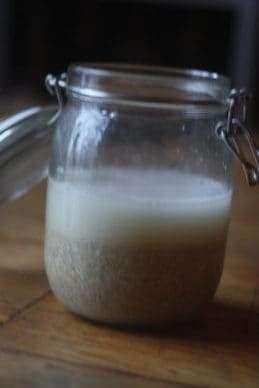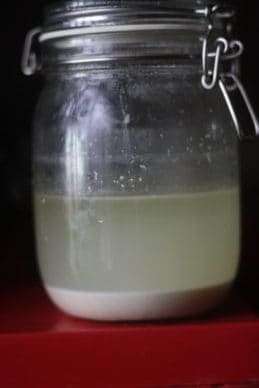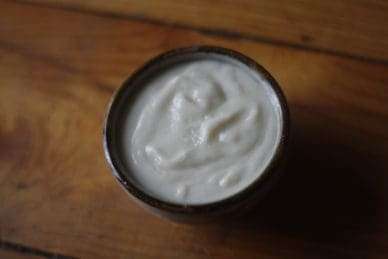“Till buttered so’ns (sowens) wi fragrant lunt (lunt – steam)
Set a’ their gabs a-steerin (steerin – mouths watering)
Syne wi’ a social glass o’strunt (strunt-Liquor)
They parted off Careerin’
Fu’ blythe that night”
– Burns : Halloween
Ah what better way than to start a post with Rabbie Burns! Here he is mentioning the rather famous (yet now somewhat forgotten) dish of Sowans ( pronounced Soo-an and written as so’ns in the poem). Sowans were once part of the Scottish traditional diet and not many households would have been without their Sowan-Bowie. More on this in a moment.
But first we need to consider how much of our folk culture and folk magic traditions are tied to our traditions of home and community. At the very heart of our homes and communities are of course food and cookery. Cooking for ones home and family is a form of hospitality which had ( and still sometimes has) a sacred character in Scotland and a way to nurture those we care for. A more familiar example of how Scottish folk linked cooking to folk magic and festivals can be found in the Bannocks. Sowans, seem to be the poor cousin these days.
The word Sowans comes from Gaelic ‘subhan’ and makes its first documented appearance in Scots in the late sixteenth century. George Ridpath in “An Answer to the Scotch Presbyterian Eloquence” (1693) assures us “That sowens are good victuals both for body and saul”. Sowans keep well, according to William Leslie in his General View of the Agriculture of the Counties of Nairn and Moray (1813): “In this country sowins are prepared at short intervals of about a week. In Caithness more art is displayed, the whole stock for half a year or more being made up at once; and similar to starch, is preserved, instead of the bran, in the form of dry paste; in which state it is sent to families resident in Edinburgh”. Sowans could also be preserved without drying for months by pouring off the clear swats and adding fresh water.
Drinking sowans were taken warm, often sweetened with treacle and thin sowans used for scones. ‘Sowans Nicht’ was another name for Christmas eve in Aberdeen and Burns links them to Halloween. Yule sowans were prepared for the festivities of Christmas but, if they don’t appeal to your taste, another use is described by William Watson in Glimpses of Auld Lang Syne (1903): “It was then quite a common practice to go with a pailful of sowens, and with a white-washing brush ‘sklaich’ the doors and windows of dwelling-houses after the inmates had retired to their beds. The houses selected for ‘sowening’ in this way were usually those of the ‘near-b’gyaun’ and unsociable folks, who never gave nor accepted of invitations for ‘Yule sowens’.” (How’s that for demonstrating the importance hospitality in Scotland?)
I think this beautifully illustrates how our customs and traditional foods are linked entirely to folk magic and folk traditions of Scotland.
It’s good not to put traditional cookery to the way side entirely for more modern conveniences because of its long history. Obviously with advancements in preserving foods some of the older techniques are maybe not as required. Food also falls out of fashion as it becomes associated with poverty and the “lower classes”. However, some of the older preserving and cooking techniques also added more nutrition we no longer access due to the invention of things like refrigeration etc. So people who still cook traditionally can actually be healthier than those who use more modern methods.
Sowans Fermenting oats a Traditional Scottish Food
One of the more renown Scottish ingredients for cookery are oats. Oats were the main grain crop in Scotland (not wheat or barley) due to the climate of Scotland. This of course was before modern farming methods were introduced. Once the oats were dried and ground, crofters and others having given the oats to the mill would get back not only the ground oats but also a bag of “sids”. These would be the oat husks (I guess we’d call this oat bran today) with little bits of the kernel still attached to them. Not wanting this to go to waste people would make Sowans out of them. A thick oat meal paste with a distinctly sour taste a bit like milk kefir if you’ve tried it. It’s not unpleasant but I think its a taste somewhat removed from the modern palate as we no longer eat many live fermented foods that have this sour profile. People tend to cover up or avoid the sour and bitter tastes preferring sugar and starch. We all know the approach to the modern diet is becoming a serious health risk. The reason Sowans are a very healthy food is that it’s a form of probiotic, similar in its use to live cultures of yogurt we take today in the form of probiotic drinks that cost a small fortune. Sowans were even on the list of foods of the Dundee Royal Infirmary in 1798. Though if you cook them into a porridge you will kill the probiotic cultures in them but still have access to the nutrients that are more easily digested because its been fermented.
So How to Make Sowens?
This recipe comes from F Marian McNeils book the Scottish Kitchen with adaptions from myself so it makes a bit more sense to us today.
McNeil suggests you fill your Sowan-bowie ( a narrow mouthed wooden tub resembling a small barrel) with your sids. Strangely, I didn’t have any wooden barrels to hand so I filled a litre kilner jar with 2/3rds oat bran and 1/3rd oats ( to mimic the sids the best I could – apparently this is also a practice that occurred in Skye if they had no Sids so I wasn’t far off) and then filled the jar up with warm water and added a little whey left over from making cheese. (McNeil doesn’t say to add Whey but figured it might get things stared a little faster and make sure it doesn’t go off). I also added a tablespoon of salt as MacNeil suggests (which I think would make this a lacto-fermentation similar to sauerkraut… happy to be corrected here!)
The bran and oats will float and they need to be pressed under the water until they are fully submerged and stop floating.
You then leave this mixture (called the “serf”) to ferment. I covered them with the clip top lid so nothing would fall in. This was left for a week. McNeil states it can take from 4 – 5 days when warm and up to a fortnight if the house is cold though suggests a week is “fair average”.
Once its fermented (where it gets the sour taste as the good bacteria get to work- it shouldn’t smell off bad at this point if it does something else has entered your ferment and you’ll need to start again) you begin the process of “the syein o’ the so’ons” that is we sieve the Sowans.
McNeil suggests you “pour the contents of the bowie through a fine sye”. I lined a sieve with muslin and used that so I could give it a good squeeze into the bowl underneath. I then rinsed this with cold water to wash off any remaining sediment and cleaned my make shift bowie.
What’s left in the muslin cloth isn’t used but as McNeil suggested I fed it to the chickens who absolutely loved the sour mash.
The liquid that comes from the squeezing was poured back into the make shift bowie (kilner jar) and left to settle for a couple of days. The mixture will separate. White paste will appear on the bottom on the jar and a yellowy liquid above that. The clear liquid is called the ‘swats’ (which you can drink as its full of probiotic bacteria like yogurt again it’s a sour taste) and the sediment is called Sowans.
What you then did with the Sowans was up to you. McNeil suggests you can use a gill (five fluid ounces) with twice as much water (2 gills or ten fluid ounces) per person (for Americans I think this is roughly half a cup to a gill) and boil it until it’s a like a thick cream (roughly ten minutes).
Other people used Sowans differently . As we have read you could cover people’s doors and windows with it if they weren’t very hospitable ( I can imagine it would be like wallpaper or flour and water paste if this dried it would be a nightmare to remove).
Other people ate it like porridge (in caithness this was called brown plate sowans) or they could be simply heated and called “gain-‘e gither” Sowans or if something lighter was desired people would pour the sowans into water and adding a touch of fresh butter this was called ‘douchrea‘. People also made Sowan Scones with the creamy Sowan paste.
I hope you will try out this cheap, healthy and versatile food stuff and I wish you luck with any of your future Sowan making activities. Please do let me know if you try this out how it goes!





11 comments
i actually look forward to trying this out, as i’m very fond of sour things. i especially like the sound of it as a beverage, and as griddle scones with butter for frying them…
It’s a taste I quite like too I hope you enjoy making it :)
I found this highly informative and can not wait to try to make it ! Thank you for taking the time to explain it so well.
This is very helpful! Thanks a lot. Do you think sowans could be used as a replacement for buttermilk when making scones and soda bread (and maybe bannocks too) as most recipes call for buttermilk but I am intolerant to dairy :(
Maybe the sour water from the sowans would work but i think the sowans themselves would make it too thick. Worth A try though !!
in the text above you mention Sowans Scones so they must have used the paste in a scone recipe as an acid, together with bicarb you’ll get a leavening effect…I have a batch of sowans going now so will try it out soon God-willing
let me know how it goes!
I have done this several times now. Have used all forms of oats in a two quart canning jar with coffee filter lid. Did not need to add anything extra like whey or kefir to get it started. The only thing that did not work was green oat straw or “milky” oats by themselves. The dried green oat straw put in water did not sour, so I presume did not turn acidic enough to protect from microorganisms that could be risky. Had to throw that one out. However. A little green oat straw mixed into other forms of oats worked fine.
I have made mine typically from what I have in the house in a mixture that I use to make oat cakes. So these are rolled plus steel cut, and oat bran. Once I found this worked fine then I bought whole oats with husk. They too worked fine to make swats and small amount of Sowens. One can increase the rate of Sowen production by adding relatively more oat bran or rolled oats that break down easily. The whole oat husks are a bit of a hassle for any other food purpose than straining off Sowens and swat because they stay very fiberous a long time and even blenderizing with a Vitamix doesn’t solve the stickery feel. However, sprouting them before putting them in adds more good nutrients to the swats and Sowens. One can feed the starter with oat bran and it keeps producing.
For my main fermenting jar though, I bought hull-less whole grains oats. I sprout these and add them to the ferment mixture periodically. I also started adding buckwheat, usually sprouted. Buckwheat contains phytase, the enzyme that breaks down phytic acid on grains and is an antinutrient. This works fine in the ferment, in the oat cakes I make from the solid part after straining, and in the swat and the sowens.
I drink the swat plain or add to other beverages, including kefir waters, kefir, kombucha and juice. I’ve also flavored it with maple syrup, vanilla and cinnamon. I am still “playing” with the sowens and testing more foods/spreads. My favorite from it has been to make a pudding. I bring milk to gentle boil that had a limited amount of ground cacao beans in it for just a hint of chocolate flavor and butter plus salt. When it hits boiling I turn off the heat to help preserve the live cultures in the Sowens. Once it has cooled a little I add the Sowens, vanilla, maple syrup and touch of cinnamon. It’s a bit lumpy because the Sowens seem to be hydrophobic and clump. But turns out I like that texture. I keep this in the refrigerator and eat a bit every night. It is light tasting but very filling. The cat begs for her taste nightly as well.
For those of us moderns who need reassurance that all is well with the ferment and are new to smelling the sourness as a guide, which probably sufficed in earlier times … I use pH test strips made for beer or kombucha. If the pH is less than 4.5 of the fermenting “mash” and liquid, it is said in the writings for these other two ferments that it is not conducive to growing the undersirable microorganisms. I do not put a lid over it, but use a coffee filter secured by rubber band as one does with making kefir. This means the alcohol mostly evaporates. I keep my jar sitting on top of the refrigerator where it does seem to get steady warmer temperatures in the winter than the rest of the house.
Because I get a rash from eating wheat, after reading your article which prompted me to start experimenting with my first batch, I have now switched to an entirely oat, buckwheat and rice based diet for my grains. So the fermenting jar remains continuously busy and restocked making the fermenting mash for oatcakes, oat pancakes, oats put in soups, in stir fries, and swats plus sowens derived recipes. Feeling much better and my rashes are finally gone. I think this process will be sustainable. I can see how it would be fine when the probiotics are preserved to do without refrigeration. However. I must admit, I like the swats better when cold and love my chilled oats-sowens pudding.
Thanks for the inspiration.
This is more of a reply than i could ever hope for and such greta learning. I love where you’ve taken it and its truly inspirational thank you :)
What a great article! I’ve recently switched to making my oat milk and have been looking for ways to use the mash afterwards ( regrettably I don’t have chickens). Also I left some oats soaking for a few days by accident and when i came back to them I noticed they were bubbling and had started fermenting…now I know what to do with the swats. Also looking forward to trying out in scones.
I don’t think it could be a replacement for butter in scone making because the butter is a fat. The sowand couldn’t possible have enough fat from just the oat germ to do the job.